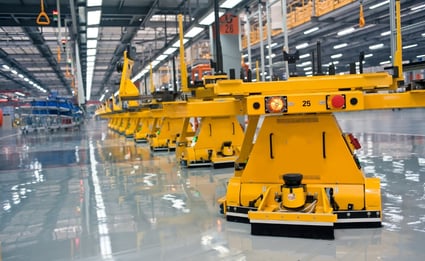5 Production Planning Strategies for Meeting Increased Demand
Jesse Kelber - February 20, 2020

Think back to the last birthday party you planned. How did it go? As the organizer, you were responsible for everything from getting invitations in the mail through to making sure you had enough drinks and cake for everybody. Then there’s ensuring that everybody got themselves home safely after the festivities (whether it was kids being picked up by parents or adults who may have needed a cab). But what happens next time when 10 of your invitees take it upon themselves to invite 10 additional people, not on the list? Demand for drinks and cake just shot up and you’re not ready for that. Or are you? This is an extremely simplified, yet apt, analogy for the role a production planner plays in keeping the business running smoothly and ensuring that when demand does spike there won’t be any disruptions.
With the party, all you have to do is send someone on an emergency run to the grocery store, while with a manufacturing business it’s a bit more complicated. Can your upstream partners supply the extra material you suddenly need? Can your warehouse handle the influx of extra finished product that needs to be shelved somewhere until the order is complete? How about logistics, are they agile enough to absorb the extra pallets? And to add to the layers of confusion, are your systems and backend processes robust enough to weather this demand spike and remain functional? Following some combination of these 5 planning strategies will help ensure you’re moving in the right direction and able to meet increasing demand without missing a beat.
1. Implement S&OP and S&OE Processes
The first key here is to understand that there are fundamental differences between sales & operations planning (S&OP) and sales & operations execution (S&OE). S&OP is the practice of planning 3-18 months in advance. The process involves stakeholders from all relevant stages of the value chain, as well as representatives from the C-suite when possible. On the other hand, S&OE deals with the immediate term, looking at operations from one day to 3 months out. The primary job of the S&OE process is to take the high-level strategic plans created by S&OP and translate them into everyday executable action items. If your organization has an S&OP process in place that includes such short-term directives, best practice is to pull these out and create an independent S&OE process. This separation allows for more strategic planning to take place, without the specter of daily action items crowding for attention. The added agility also gives you the ability to pivot to better meet demand.
2. Make Judicious Use of Industry 4.0 Technology
As a production planner, technology is one of your biggest allies. The emerging tech being implemented in production facilities around the globe is helping these concerns keep up with demand spikes, increase capacity, and provide the visibility into the end-to-end supply chain that’s required to make it all work seamlessly. Sensors on manufacturing equipment send real-time data to a dashboard so you’re always up-to-date on current capacity, making adjustments on the fly when needed in order to keep up. These IoT-powered sensors, combined with the AI-backed advanced analytics that have recently come to market, allow for robust predictive maintenance flows, lowering the chances of unexpected machine downtime causing disruptions.
3. Deploy an Appropriate SCMS Solution
Supply chain management software (SCMS) solutions are your best bet for simplifying the management of every step of your end-to-end supply chain. Details will differ, of course, but a basic solution will include modules for:
- Sourcing/supplier management
- Client requirement documentation
- Purchase order processing
- Inventory management
- Sales and distribution
Integration is a key function to look for, as this is what will allow your SCMS to work in conjunction with your existing CMS, ERP, HRIS, and CS systems. Another key piece to be aware of is scalability. A solution that can grow with your company, easily deploy to new locations, and offer additional modules that are simple to enable when the time is right, will allow you to use a single solution for the foreseeable future.
4. Integrate Legacy Systems
Even if you’re not in a position to deploy a suitable SCMS solution, there are steps you can take to integrate your production planning with both up- and down-stream partners, as well as other internal stages of the supply chain, to help stay agile in the face of fluctuating demand. What do we mean by “legacy system?” In this context, it can refer to anything from a clipboard hanging in the warehouse whose data gets entered into a spreadsheet every night, to a fully computerized system that was put in place anywhere from 10-30 years ago. Many, many such systems are still hard at work across sectors up and down supply chains today. When it comes to meeting increased demand, quickly, the crucial and often missing piece of the puzzle is access to the necessary data. Whether that means getting that clipboard data entered more frequently, or roping in development to write code that retrieves upstream supply data in something closer to real-time—there are ways to work with whatever you find to streamline the processes and bring production into line with real-world demand fluctuations.
5. Be Agile
If we had been asked to trim this list to our top 1 suggestion, this would be it. Agility is critical for each of the other strategies, as well as for staying competitive in today’s market—no matter your product. The word “agile” here refers not to the established management methodology common in the software development realm, but rather to the more basic notion of keeping a business process (like production) flexible enough to absorb unforeseen complications and disruptions. With this in mind, you may want to start by brainstorming with key stakeholders to find out what they view as the processes that are holding them back. Or, you might want to start by looking at your own budgetary or infrastructure situation to determine where the best place to start is in order to keep up with the rest of your value chain. No matter what you find during this initial investigation phase, there will be actions you can take today that will help increase access to data, improve the accuracy of your demand forecasting, or in some other way help you position yourself to meet demand, no matter the fluctuations in your market.
If you want to learn more get your Guide to Industry 4.0:
LATEST POSTS
- Understand Circular Economy in The Manufacturing Industry
- How Can Industry 4.0 IT Integration Be Achieved Smoothly?
- The Significance of Order Sequencing in Discrete Manufacturing
- How to improve your Supply Chain Management: The Power of Control Towers
- Optimizing Human Resource Scheduling in Manufacturing: A Technological Approach



